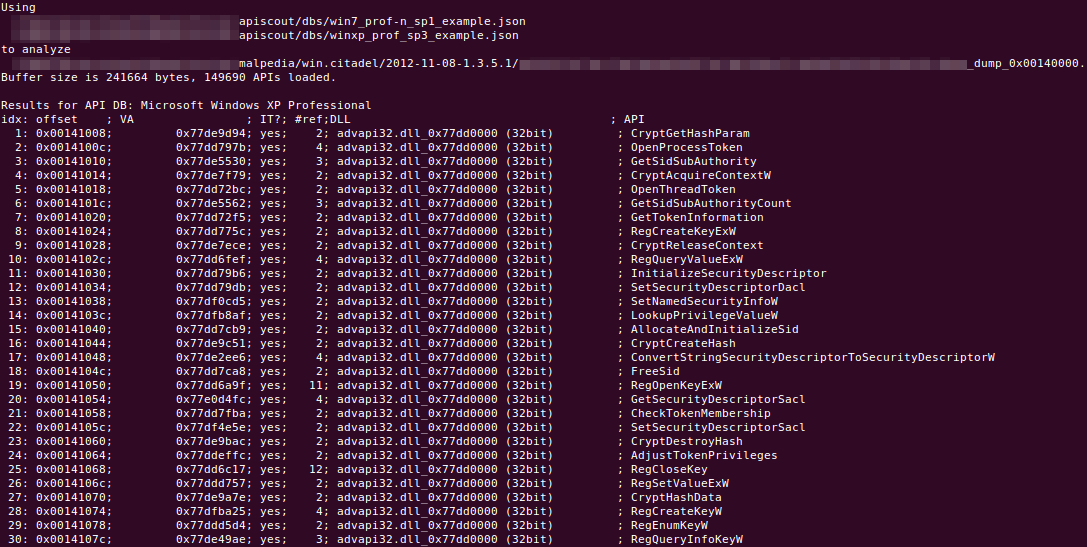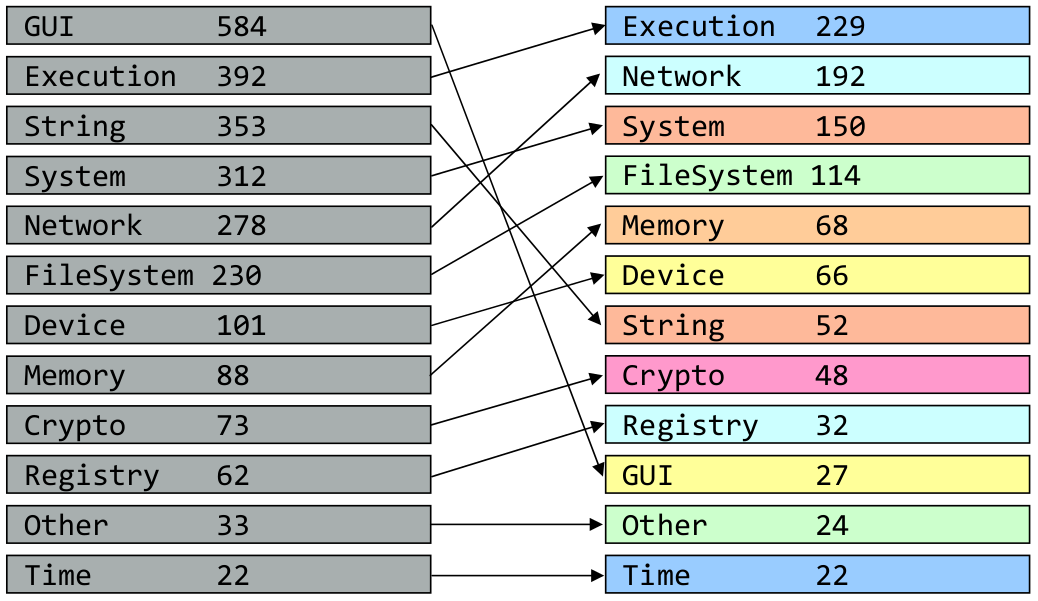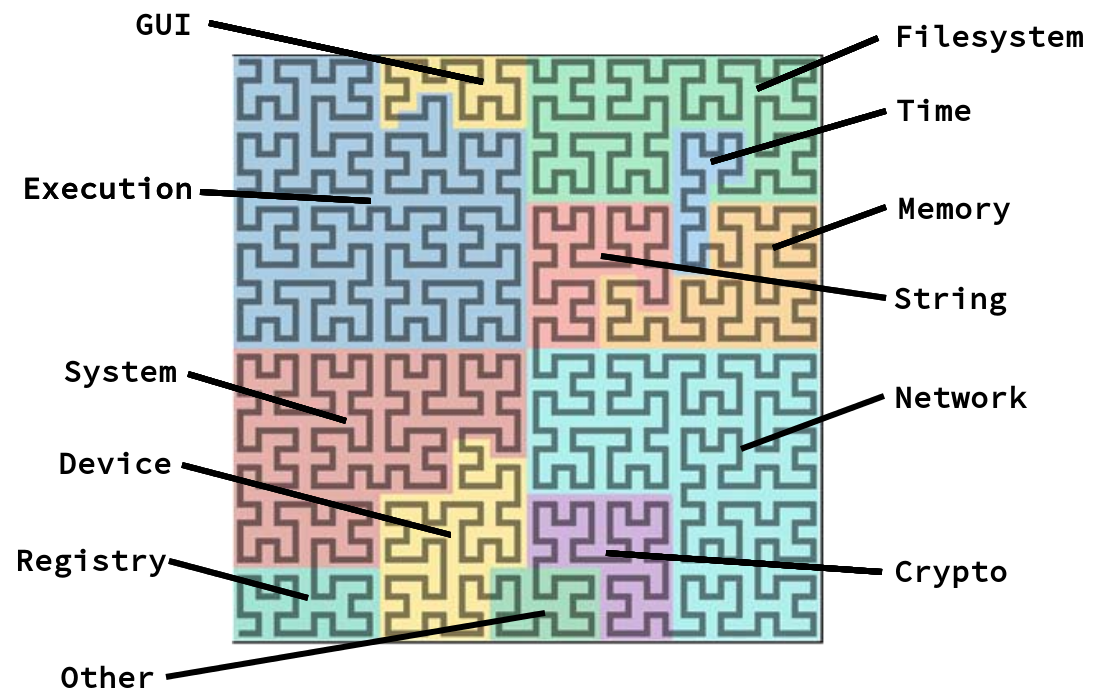Upgrading ApiScout: Introducing ApiVectors
About a year ago, I published ApiScout, a library that allows the recovery of potentially used Windows API functions from memory dumps.
The approach can be outlined as checking all DOWRDs/QWORDs of a memory dump against a previously created collection of DLL information for a given Windows instance. It has been used in the recently published paper on Malpedia, where it was used to compare Windows API usage behavior of 382 malware families.
In this blog post, I want to explain the additions to ApiScout that I have done together with Steffen Enders, namely the introduction of ApiVectors. ApiVectors are a compact representation of “interesting” API functions extracted with ApiScout that can be used to get a first impression of a malware’s potential capabilities but may also serve for matching against a reference database to aid in malware identification.
ApiVectors
The output of ApiScout is a list of tuples, consisting of the following elements:
- offsets:
- in the buffer where a potential API address has been found
- the dword identified as DLL/API address
- its membership in the PE header’s Import Table (if applicable)
- an estimate how many times it was referenced in the code
- the found DLL / API name
Here is a shortened example result for a Citadel binary:
Naturally, we now wanted to find a decent way to store this information, preferably in a compact format that maintains as much relevant information as possible. In our previous work on Malpedia we found that you encounter “only” around 4.000 unique APIs (out of 50k+ found in a Windows installation) across the 380 malware families, with very few being common (top150 APIs present in ~25% of the families) and many being found in just few families (90% of the APIs present in 10% or less of the families). Of course, we could easily use the full set of APIs as base vector but that would mean super sparse vectors since we also found that on average, 120-150 APIs are found in a given malware family.
Because we wanted this vector to carry information useful to analysts, we had a closer look at the semantic context of the API functions. So we went ahead and labeled ~3.000 of the API functions into the following 12 groups (with counts per group):
- 584 GUI
- 392 Execution
- 353 String
- 312 System
- 278 Network
- 230 Filesystem
- 101 Device
- 88 Memory
- 73 Crypto
- 62 Registry
- 33 Other
- 22 Time
An immediate observation is that there are many API functions related to GUI and string handling that potentially are less interesting to an analyst, the same holds true even within more relevant groups. Instead of covering everything, our representation should definitely focus on really meaningful suspicious aspects like interacting with the system or network.
In our efforts for reduction, we first apply some simplifications to Windows API names:
- We drop the string type, i.e.
AorWif applicable - We ignore MSVCRT versions, i.e.
msvcrt80.dll!timebecomingmsvcrt.dll!time
Some quick experiments showed that the information lost by this step is negligible.
We then went ahead and designed a custom vector of size 1024 that is roughly based 80% on the occurrence frequency as found in our Malpedia evaluations and 20% based on domain knowledge of interesting API functions that should definitely be included. This leaves us with the following result:
The vector we have settled for can be found here. Feedback welcome! :)
Visualization: ApiQR
One cool thing that you can do with a vector of length 1024 is fitting it into a Hilbert curve to achieve a nice way to visualize the information. The Hilbert curve ensures that neighboured entries appear next to each other, while also filling the given space. We call these diagrams ApiQRs:
Here are some example visualizations for a few families. You can also click them to have their vectors viewed in Malpedia:
RockLoader:
A8gAgAFAIA3gA7IA4EAACA7CQA4QA8QABA3EA6FAEA5CA3IA69BAEAABAABA10
TeslaCrypt:
AAgAAgAAwAgAFQIAQMwysA5JA3gEQAgACA3BgCQLAAQACFCgIAIAELJBIA5QBL }AEAiA3GAEQA58EgIASwA6BABAABAgA6QAKIA
Citadel:
ErkAAQIABBpe,QIgUIwytA5JzhgAOYAm.aBhMwBq]Ot+twChA,]gIABLBAYCiV MswMAZACAA?BjBEIQAAgAIwj-aBCQNA5QAIAD,-eQoiQkQmBAH]DA3ngACAAQA EEAALI-kAE^acSzABCAABhSBEAREgBhgEQCXoYI+
DarkComet:
AARogzQx/,wIiQcwCuABj.RJDlujHYQgv*AC,_fe@LO-}TIcIA3IasLJBgCAnt MwNLFAEAAYhlADAQABgEAxAQCAAQAAIA3wAMAz_kYitAQhAFA10BD_^/fDMBn. -_mADwgASgDTkAAEgPFNDHAgbBhIAGToaKQ
| some | examples |
|---|---|
 |
 |
| RockLoader | TeslaCrypt |
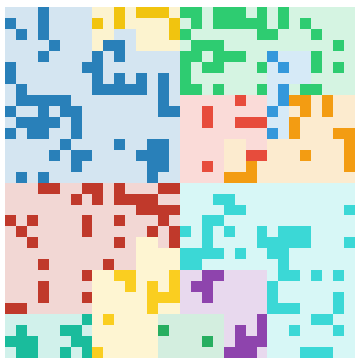 |
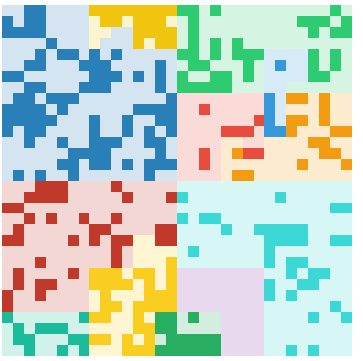 |
| Citadel | DarkComet |
Next we explain how the base64 like representations shown previously are created.
Compact Representation of ApiVectors
You may be interested how the above base64-like strings (e.g. for RockLoader: A8gAgAFAIA3gA7IA4EAACA7CQA4QA8QABA3EA6FAEA5CA3IA69BAEAABAABA10) are constructed.
We actually use an alphabet of 74 printable (and hopefully not too tool-conflicting) characters in a way that is actually very similar to base64.
Our custom base64 alphabet has the characters:
"ABCDEFGHIJKLMNOPQRSTUVWXYZabcdefghijklmnopqrstuvwxyz@}]^+-*/?,._"
and we add the 10 numbers to later allow us to use runlength-encoding.
Similar to base64, each character of the alphabet encodes 6 bits of the vector and the mapping is the following:
'000000' -> 'A', '000001' -> 'B', '000010' -> 'C', '000011' -> 'D', '000100' -> 'E', '000101' -> 'F', '000110' -> 'G', '000111' -> 'H', '001000' -> 'I', '001001' -> 'J', '001010' -> 'K', '001011' -> 'L', '001100' -> 'M', '001101' -> 'N', '001110' -> 'O', '001111' -> 'P', '010000' -> 'Q', '010001' -> 'R', '010010' -> 'S', '010011' -> 'T', '010100' -> 'U', '010101' -> 'V', '010110' -> 'W', '010111' -> 'X', '011000' -> 'Y', '011001' -> 'Z', '011010' -> 'a', '011011' -> 'b', '011100' -> 'c', '011101' -> 'd', '011110' -> 'e', '011111' -> 'f', '100000' -> 'g', '100001' -> 'h', '100010' -> 'i', '100011' -> 'j', '100100' -> 'k', '100101' -> 'l', '100110' -> 'm', '100111' -> 'n', '101000' -> 'o', '101001' -> 'p', '101010' -> 'q', '101011' -> 'r', '101100' -> 's', '101101' -> 't', '101110' -> 'u', '101111' -> 'v', '110000' -> 'w', '110001' -> 'x', '110010' -> 'y', '110011' -> 'z', '110100' -> '@', '110101' -> '}', '110110' -> ']', '110111' -> '^', '111000' -> '+', '111001' -> '-', '111010' -> '*', '111011' -> '/', '111100' -> '?', '111101' -> ',', '111110' -> '.', '111111' -> '_'
Now, take the following raw, uncompressed ApiVector of RockLoader shown above and the corresponding encoding per 6 bit below each row:
000000000000000000000000000000000000000000000000 A A A A A A A A 100000000000100000000000000101000000001000000000 g A g A F A I A 000000000000100000000000000000000000000000000000 A A g A A A A A 000000000000001000000000000000000000000000000100 A A I A A A A E 000000000000000010000000000000000000000000000000 A A C A A A A A 000000000000000010010000000000000000000000000000 A A C Q A A A A 010000000000000000000000000000000000000000000000 Q A A A A A A A 000000010000000000000001000000000000000000000100 A Q A B A A A E 000000000000000000000000000000000000000101000000 A A A A A A F A 000100000000000000000000000000000000000010000000 E A A A A A C A 000000000000001000000000000000000000000000000000 A A I A A A A A 000000000000000000000000000000000000000000000000 A A A A A A A A 000000000000000000000000000000000000000000000000 A A A A A A A A 000000000000000000000000000000000000000000000000 A A A A A A A A 000000000000000000000000000000000000000000000000 A A A A A A A A 000000000000000000000000000000000000000000000000 A A A A A A A A 000000000000000000000000000000000000000000000000 A A A A A A A A 000000000000000000000000000000000000000000000000 A A A A A A A A 000000000000000000000000000000000000000000000000 A A A A A A A A 000001000000000100000000000000000001000000000000 B A E A A B A A 000001000000000000000000000000000000000000000000 B A A A A A A A 0000000000000000(00) A A A
(Small remark: Obviously we have to pad with 2 bit because 1024 % 6 == 2.)
Now, one thing that is obvious is that vectors can be very sparse and we can probably condense the representation further. For this we use runlength-encoding, with which we can remove the repetitive consecutive symbols, for which we freed up the 10 numbers from the original base64 alphabet before.
With that, we can now “compress” the vector as follows.
Uncompressed:
AAAAAAAAgAgAFAIAAAgAAAAAAAIAAAAEAACAAAAAAACQAAAAQAAAAAAAAQABAA AEAAAAAAFAEAAAAACAAAIAAAAAAAAAAAAAAAAAAAAAAAAAAAAAAAAAAAAAAAAA AAAAAAAAAAAAAAAAAAAAAAAAAAAABAEAABAABAAAAAAAAAA
Compressed:
A8gAgAFAIA3gA7IA4EAACA7CQA4QA8QABA3EA6FAEA5CA3IA69BAEAABAABA10
This is also the final representation.
Here are some statistics, taking malpedia as basis (1957 dumps for 637 distinct families):
- Avg number of unique APIs per dump: 121.633
- Avg number of APIs represented in ApiVector: 100.053 (82.258% coverage)
- Avg ApiVector length (compressed): 92.438 bytes
- Compression Rate (vs. 172 bytes uncompressed): 1.86x
So given that the whole content in the vector can be recovered, that’s pretty cool.
Okay, but how can I use this?
You can easily incorporate ApiVectors into your own analysis environment. For starters, the previous blog post on ApiScout explains how to build a DB custom to your Windows system. After this, you can simply crawl arbitrary buffers (e.g. memory dumps of selected suspicious segments from processes) for their API information and have this available in your other analysis such as IDA Pro.
If you do not want to use ApiScout to crawl memory dumps, you can also create ApiVectors directly from a given list of Windows API functions (e.g. Import Tables) using getApiVectorFromApiList() and getApiVectorFromApiDict() from the ApiVector class respectively.
A concrete use case for ApiVectors is matching them against each other. In that context, projects like ImpHash and ImpFuzzy may come to mind. The advantage of ApiVectors is that they actually carry the identity of API functions used without abstracting them with only little higher cost in terms of required storage. We are currently looking to hook our approach up with sandboxing, e.g. Cuckoo.
Our current experiments indicate that using similarity of ApiVectors may in fact serve as a decent way to perform malware family identification. As announced, we will cover this in a future blog post and full paper summarizing all of our findings around ApiScout.
